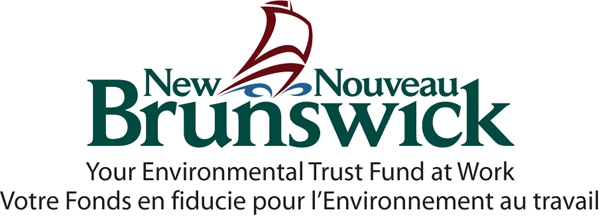The Wild Pollinators & Their Natural Habitats project’s purpose is to protect wild pollinators by adopting respectful practices towards their natural habitats. With the help of a series of consultations, workshops and a pilot project with landowners of the Cocagne watershed region, the PCSDG desires to increase wild pollinator populations, as well as biodiversity within southeastern New Brunswick.
In February 2016, the United Nations presented a study on the importance of pollinators’ roles for the future of food production and, thus, food security on a global scale. Indeed, according to this study, 75% of key agricultural crops, as well as 90% of wild flowering plants depend on animal pollination.


Black Swallowtail (left) with Common Wood-Nymph (right)
This project aims to achieve several objectives :
-
Improve and multiply the potential habitats of wild pollinators;
-
Increase the number and biodiversity of wild pollinators;
-
Improve the health of wild pollinator populations, which also contributes to the stabilization of domestic pollinators;
-
Improve the resilience and adaptation to climate change of wild pollinators;
-
Ensure the health of forests, grasslands and other habitats of wild pollinators;
-
Reduce the risk of some common practices that have a negative effect on pollinators;
-
Sensitize populations to the essential roles played by wild pollinators.




To achieve these goals, the PCSDG piloted a project in 2017 within the community by partnering up with landowners. As part of this pilot project, experts were consulted to develop scientific methods and project-specific parameters. In August, project leaders Louis-Émile Cormier and Stuart Tingley set-up and staffed an information booth during the festival Les Cocagneries. Approximately 100 visitors became aware of the project and the importance of indigenous and wild pollinators as well as their habitats. We recruited landowners for the pilot project in Cormierville, Cocagne, Lover’s Lane and Grande-Digue. From July to October, Cormier and Tingley observed and documented many pollinators, as well as plants that attract pollinators, on 4 different sites. The PCSDG collaborated with the Atlantic Canadian Conservation Data Centre to ensure proper identification of the observed species. Following the loss of one participant at the last minute, Tingley met with the local arena’s board of directors in order to secure 0,5 hectare of land to plant a wildflower meadow and promote indigenous and wild pollinators. The project was approved and the PCSDG became the recipient of the Native Wildflower Seed Grant of Wildlife Preservation Canada, allowing us to purchase a wildflower seed mixture specially prepared with our territory and species in mind! Furthermore, two bee nest boxes were installed per field and milkweed, as well as Joe-pye weed seeds were sowed.

During winter, Tingley reviewed the collected data, including a series of high quality photos, in order to identify the common and latin names of the pollinators, as well as the plants in proximity to each species observed. Certain photos were shared through posts via the PCSDG’s Facebook page while a significant portion of photos were added to a project page stemming from the iNaturalist site. The site is : « a place where you can record and share what you see in nature, meet other nature watchers, and learn about Canada’s wildlife. By participating as a citizen scientist you can contribute to a growing wealth of knowledge of Canadian species and help conserve our natural world.” A very well organized database, iNaturalist contributes to an expanding body of global data collection such as the Global Biodiversity Information Facility and, in return, is widely used by conservationists and biologists for data collection : « iNaturalist Canada is run by the Canadian Wildlife Federation (CWF) and the Royal Ontario Museum (ROM) in collaboration with iNaturalist.org at the California Academy of Sciences. Parks Canada, NatureServe Canada and Hinterland Who's Who have been key partners in the development of iNaturalist Canada and continue to play a role in the program.”

Gallium Sphinx

Spotted Joe-Pye Weed
Together, plants and pollinators are a valuable natural resource, and their day-to-day work is essential, especially for the production of apples, pears, cucumbers, melons, berries and many other types of Canadian farm products. According to Pollination Canada (2016), since 2006 we have seen a significant decline in pollinator populations worldwide. Pollinators, which include bees, wasps, flies, beetles, butterflies and moths, bats and birds, are under pressure from the loss of their habitat (where they nest), the loss of food sources (plants that provide nectar and pollen), pests and diseases, and chemicals (pesticides and herbicides). Since pollinator populations are threatened, so are the foods and plant products we enjoy (fruits, vegetables, tinctures, oils, medicines, fibre, perfumes and even oxygen). In addition, the wild ecosystems that depend on these pollinators (for example, other wild animals that rely on plants) are also at risk. The PCSDG believes this project will help restore pollinator populations within the region through the establishment and sharing of beneficial practices for their reproduction. By educating people about the important role of wild pollinators, we are also helping to reduce practices that threaten their survival.
For more information and photos regarding the documented pollinators in Cocagne, you can also consult the Cocagne, NB Pollinisateurs / Pollinators page stemming from the iNaturalist global and interactive database.
Publications
- New! (2020) Public Education on Butterflies in the Cocagne area (in French)
- 2019 Public Education on Butterflies in the Cocagne area
- Butterflies of Cocagne brochure
- Video: Monarch life cycle
- Video: Presentation on Monarch butterflies by Rhéal Vienneau
Acknowledgments
The Pays de Cocagne Sustainable Development Group would like to thank New Brunswick Environmental Trust Fund for their support in this project.

